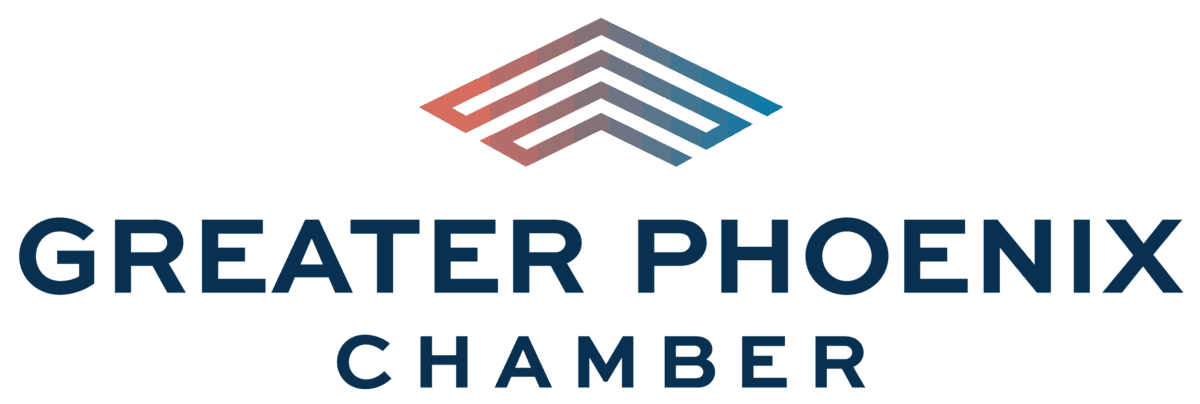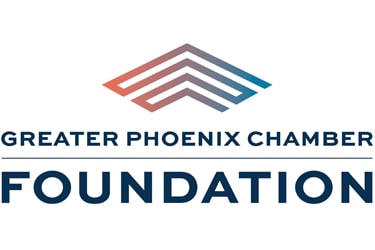Last month, the Greater Phoenix Chamber Foundation launched the Reimagining Today’s Workforce Webinar Series. In an everchanging workforce landscape, this series connects employers and community leaders with tools and best practices to support their talent development strategies, provide current workforce trends, highlight partnerships with education providers, and more.
The series of five webinars feature national and local experts on relevant workforce issues like returning to a physical workspace, the importance of childcare in reopening the economy, hiring trends, and more.
Back to the Office Strategy: New Ways of Working and Contact Tracing
The Foundation welcomed Max Rasovsky and Erik Steffensen of PointB to kick-off the webinar series with a presentation exploring how employee safety will lead organizations back into the workplace and review the rapid deployment of advanced technology.
“This topic is very important to the business community as we continue to navigate the changing work environment amid a public health crisis,” said Todd Sanders, President and CEO of the Foundation.
Rasovsky and Steffensen discussed methodologies and tactics regarding returning to a physical office space amid the COVID-19 pandemic and beyond.
The workforce experts shared that six to 12 months before COVID-19, many workplaces were already heading toward major workforce changes as several forces, including competition for talent, different ways of working, growing without growing costs, being business agile, and many more.
Point B has been focused on helping businesses cope with those forces utilizing a four-dimensional approach distinguished by human, physical, mechanical, and digital aspects of the workplace experience.
Steffenson shared how these four dimensions changed as a result of the COVID-19 pandemic and the transition to remote working. He cited issues including productivity, mental health, digital bandwidth, in-home workspace, and many more.
“We tried to advocate that there are fairly strict principles that people can abide by to try and frame the decisions that they have to make when figuring out how to get people back into the office, or how not to,” said Steffenson. He shared that employers should consider safety, equity, and choice when making these critical decisions.
He emphasized the importance of developing different options and crisis response plans for each of those options and encouraged employers to make the process holistic and employee centered.
“The bottom line is that you are making yourself a much more resilient organization,” said Steffenson.
Rasovsky then shared specific options and tactics available to employers as they either continue to refine their return to work strategy or develop a strategy to returning to a physical office space. Specifically, he highlighted the importance of contact tracing in an office setting.
He encouraged employers to rely on technology, including apps, to help facilitate contact tracing and identify potential clusters of COVID-19 in ways that minimize the operational disruption to the workplace.
The Childcare Equation: COVID-19, Parents, & Employer Solutions
On September 10, the Foundation hosted a robust discussion with policy leaders and employers about the intersection of workforce, childcare, and economic recovery.
Julia Barfield, the Senior Manager of Policy and Programs for the U.S. Chamber of Commerce Foundation‘s Center for Education and Workforce, joined the virtual event to provide a broad overview of the state of childcare across the country. She shared a comprehensive overview of workforce and childcare, where she explained the national trends around the return to work and the challenges that working parents—and their employers—face when finding childcare solutions.
According to the data shared by the U.S. Chamber of Commerce Foundation, 75% of working parents have children who are staying home, and 1 in 5 parents are not sure that they will be able to return to their pre COVID-19 work situation.
“We are seeing the supply of childcare decrease significantly, and we are concerned that it is only exacerbating the problem we saw pre-pandemic,” said Barfield. “When we’re talking about the impact of COVID-19 on childcare broadly, we’re looking at three categories. We’re looking at employers; obviously, we’re very concerned about the impact on your ability to return to work. We’re also looking at working parents and how they are balancing. […] And then, we are also looking at childcare providers.”
She shared that the majority of childcare in the U.S. is provided by small, privately owned businesses.
“They are a pretty impactful industry,” said Barfield. “They generate about $47 billion annually in revenue for the economy.”
Following the presentation, Lorraine Field, Chief People Officer, Sonora Quest Laboratories, and Larry Hofer, Vice President, People Solutions, Cox Communications, joined the discussion. Their remarks centered around how employers with essential and non-essential employees are leading through the crisis while emphasizing safety and flexibility for employees.
“Many of our employees are essential, so what we’ve done is work hard to accommodate flexible schedules and talking to our employees about what would meet their needs,” said Field. “What’s great about being a 24-hour operation is that we’ve been able to shift people to work different hours than they typically would.”
Field shared that Sonora Quest Laboratories has also partnered with local childcare providers to develop solutions for their employees.
“What we try to do is provide childcare accommodations,” said Hofer. “We have different types of schedules, flexible work hours. We also have what’s called block schedule where employees can take time off during the day to attend to personal matters.”
Hofer shared that block scheduling allows employees to focus on personal matters during the traditional workday and attend to work matters in off-hours.
Barfield emphasized that the examples shared by Sonora Quest Laboratories and Cox Communications illustrate how companies can innovate through this crisis to meet their business needs and their employees.
“These are some extraordinary times, and we are all trying to figure it out together,” said Hofer.
All of the speakers encouraged employers to be innovative, be flexible, and take chances on new working solutions to meet employees’ needs during these unprecedented times.
To view more resources to help employers understand the economic importance of quality childcare and early childhood education, and how businesses can support working parents, click here.
The Reimagining Today’s Workforce Series is a series of five webinars featuring national and local experts on key topics related to workforce development. Attend future webinars on October 8, November 12, and December 10.
-Written by Miranda Cain-Morton, Senior Development & Communications Manager
payday loan срочный займ на карту без проверки кредитной историизайм экспресс оплатабыстроденьги займ взять займ онлайн на qiwiзайм рассрочказайм вива деньги займ 30000 на карту срочнозайм 100 рублей на кивичастный займ без залога


